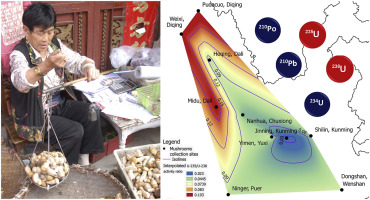当前位置:
X-MOL 学术
›
Chemosphere
›
论文详情
Our official English website, www.x-mol.net, welcomes your
feedback! (Note: you will need to create a separate account there.)
Bolete mushroom Boletus bainiugan from Yunnan as a reflection of the geographical distribution of 210Po, 210Pb and uranium (234U, 235U, 238U) radionuclides, their intake rates and effective exposure doses.
Chemosphere ( IF 8.1 ) Pub Date : 2020-04-07 , DOI: 10.1016/j.chemosphere.2020.126585 Dagmara Strumińska-Parulska 1 , Grzegorz Olszewski 1 , Aleksandra Moniakowska 1 , Ji Zhang 2 , Jerzy Falandysz 3
Chemosphere ( IF 8.1 ) Pub Date : 2020-04-07 , DOI: 10.1016/j.chemosphere.2020.126585 Dagmara Strumińska-Parulska 1 , Grzegorz Olszewski 1 , Aleksandra Moniakowska 1 , Ji Zhang 2 , Jerzy Falandysz 3
Affiliation

|
This pioneering study aimed to determine the activity concentrations of 210Po, 210Pb and uranium (234U, 235U, 238U) radionuclides in fruit bodies of wild bolete Boletus bainiugan Dentinger and to estimate its edible safety, which may give scientific evidence for the consumption of this species. The analyses were performed using alpha spectrometer after digestion, exchange resins separation and deposition. Measurement data were analysed and interpolation maps reflecting 210Po, 210Pb and uranium (234U, 235U, 238U) geographical distribution in Yunnan province (China) were presented. In addition, from the perspective of food safety, the possible related effective radiation dose to mushrooms consumers were estimated. The results indicated that 210Po, 210Pb and uranium (234U, 235U, 238U) radionuclides contents in B. bainiugan were significantly different with respect to geographical distribution, and their possible intake in a part of the region was considerably higher. A very interesting observation was done according to the values of 235U/238U activity ratio indicating the occurrence of uranium faction from the global fallout of nuclear weapon tests.
更新日期:2020-04-08











































 京公网安备 11010802027423号
京公网安备 11010802027423号